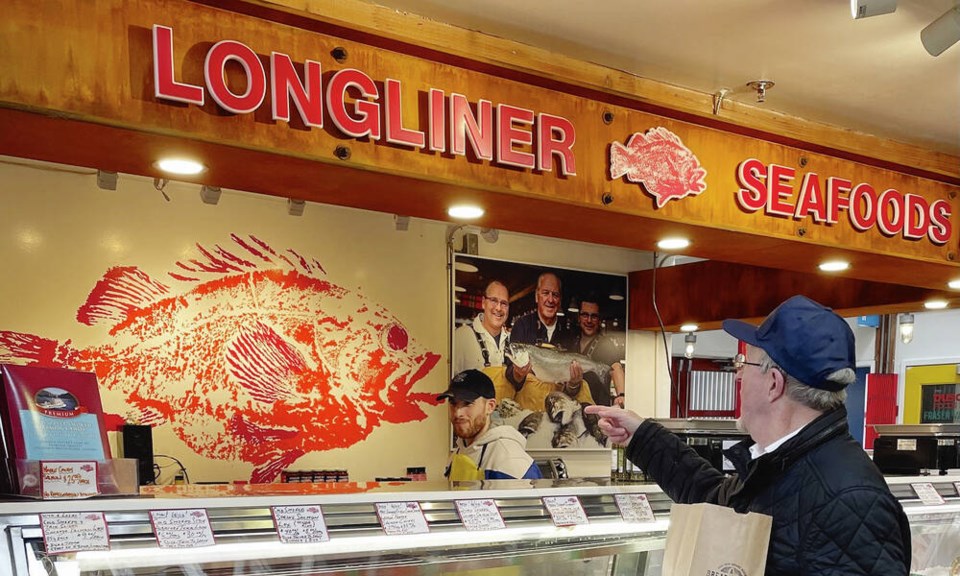A commentary by a Victoria designer and architectural historian.
The key word in public markets is “public,” because almost all privately owned “public market” experiments and development teasers that I have experienced and studied have failed, or are shrinking.
Let’s examine the principles for the success of public markets.
First, my market credentials.
By creating and selling crafts including silver jewellery at one of sa国际传媒’s oldest farmers markets, I graduated from university debt-free.
Do I like public markets? Resoundingly, yes.
After university I painted mainly outdoor murals in Vancouver; some were very well known. Those murals led to an invitation to decorate the Gastown Farmers Market, which led to being selected to design and decorate the first three market stalls at the Granville Island Public Market, working with architect Norm Hotson.
We changed Vancouver with that market. My red snapper mural is still intact at Longliner Seafoods, and the Granville Island Public Market is a huge success. That success took years to develop, requiring patience and a mandated producers-only rental policy.
Many stalls sat empty for the first two years while import vendors and other retailers, who saw the crowds, asked to fill the empty stalls. Granville Island was eventually filled with only direct producers and farmers, because it was publicly owned, without an over-riding, short-term profit motive.
When I moved to Victoria, the only all-organic farmers’ market was the Sunday Metchosin Farmers Market, 25 kilometres away.
That is where I shopped for many years, and I can happily report that market is still thriving today.
The very popular Moss Street Farmers Market has now gone mainly organic, shortening my shopping trips.
With many farmers markets, we are very lucky on Vancouver Island. (Try the year-round Comox Valley Farmers Market on Saturdays if you are in the area.)
Now the other side of the story.
I, and many others, lost thousands of dollars at a privately owned “public market” venture in Victoria, possibly due to only one missed step by the developer, but definitely because it was privately held and profit motivated, rather than a growers’ and producers’ food-centric market.
Value Village was the site, where we were promised windows onto the harbour and a large eating deck for the public. Imagine the view from that deck as if it were built.
We got a manager who fled with our money and his opioid addiction instead of the deck. It was a very quick failure.
That market was a private venture, with no civic or public responsibility, despite the name Victoria Public Market.
The Hudson Public Market in Victoria is slowly shrinking. It is privately owned and managed, without any farmer control or any public stewardship, despite the boldly displayed name Public Market on Douglas Street.
I did some design consulting for the Hudson/Townline development and told them that their market plan would not succeed without the loss of one retail space on Fisgard Street to create another entry and allow more natural light.
Public markets are not shopping malls, they require easy access and egress for shoppers, and in my experience, they need abundant natural light. No successful market that I am aware of, from Vienna to Victoria, overlooks these principles.
The shrinking of the Hudson Public Market is the motivation for my discussion today.
We are being promised yet another public amenity, of a “public market,” as one of the carrots that will allow a serious shadowing of parts of Victoria West by a shoreline tower of 30 storeys.
What will we actually receive in return?
This developer may have the best of intentions, just as I think Hudson wanted a successful market as well. When faced, however, with decisions that could cost money and/or reduce profit by making selections and decisions that probably would have a higher front-end cost, but probably would lead to long-term success, what choices will be made?
Will a developer wait years to lease all the stalls to appropriate vendors, as Granville Island did?
I hereby propose for the reasons stated above, and a myriad of other examples that could be given, that the “Roundhouse Public Market” portion of the Focus/Bayview development, be a public-private partnership with actual public investment and decision making.
No other solution will see something like a Victoria version of Toronto’s St. Lawrence Market or the Granville Island Market, thriving enough to provide a genuine, long-lasting public amenity in Victoria West.
Anything less than a public-private partnership will probably see the developer explaining in the near future why the public market did not work and why it should become a car dealership, or offices, or townhomes.
Finally, I’d like to point out a semantic variable, but one that may be key to the entire discussion. The most successful and long-lasting public markets are often farmers markets such as the successful indoor /outdoor farmers market in Ottawa, and the now expanding farmers market addition at the St. Lawrence Market.
I am not aware of a privately owned and controlled public market that is successful. Private malls have been successful, at least in the past, but it should be noted that many malls are now being redeveloped for residential use.
>>> To comment on this article, write a letter to the editor: [email protected]



